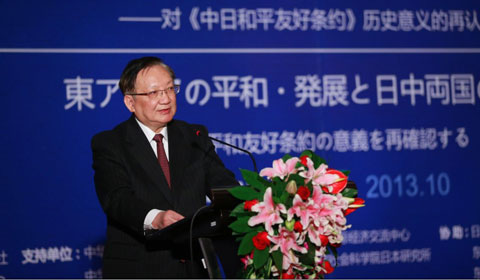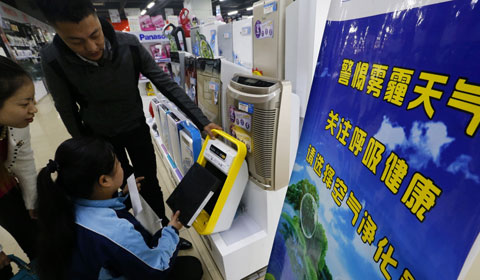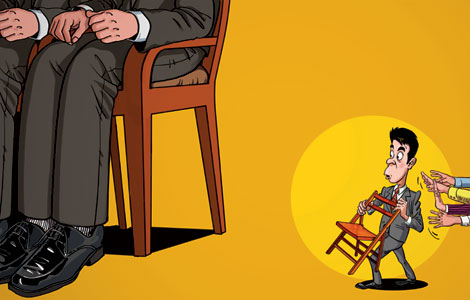Beijing's new energy structure to use 8% coal
Updated: 2013-10-26 15:50
(cntv.cn)
|
||||||||
As winter approaches, China's capital is now rolling out new energy alternatives, to cut its reliance on coal by 13 million tons by 2017. But with coal the main source of power for its central heating, that target remains ambitious.
CCTV reporter Grace Brown went to see one of a new generation of thermal plants outside the city, to see how natural gas could help Beijing rise to the challenge.
In Beijing, air quality is often so bad, it rates as 'hazardous to breathe' by the World Health Organization. Burning coal, the black fuel, has been its staple for decades. When long and freezing winters call for vast -- and cheap -- central heating, across north China.
But now things are changing.The central government is offering 5 billion yuan; or about 818 million dollars; in financial incentives to Beijing and its neighboring provinces, to improve their air quality. And the notoriously smoggy capital is stepping up.
This is the Beijing Jingxi gas fired thermal power station, just outside the capital. It uses natural gas to provide heating to the capital. And projects like this are growing. By 2017, Beijing will have 24 billion cubic meters of natural gas coming in from western China.
According to the Beijing Municipal Development and Reform Commission, half the total budget to make Beijing more carbon-friendly comes from the government... Bringing a major change to the city’s energy structure. With the use of coal more than halved by 2017.
"In 2012, coal accounted for 25% of Beijing’s energy consumption, at 23 million tonnes. While clean energy including natural gas accounted for 75%. In 2017, Beijing’s coal consumption is expected to be reduced to within 10 million tonnes, taking 8% of Beijing's total energy use. Clean energy will be increased to more than 90%." Gao Xinyuy, Deputy Director of Beijing Mnicipal Dev't and Reform Commission said.
Beijing is also cutting down on diesel vehicles - another key contributor to its air pollution.
"Before 2004, diesel and gasoline buses were widespread in Beijing, emitting black smog. Since our five-year bus transforming campaign though, many bus companies have replaced them with clean energy models. For the Beijing Olympics, we launched the first round of electric buses in China. And from 2010, new energy buses became mainstream." Zhong Qianghua, Chief Engineer of Beijing Public Transport Corporation said.
By 2017, 70 percent of the city's electricity will come from outside provinces, such as Shanxi. That means less coal burning in Beijing. But not necessarily outside it Nevertheless, it's use of more alternative energies is a step in the right direction.
- Liquefied natural gas is new energy darling
- Road to clean air starts with new energy vehicles
- Conference focuses on new energy, green economy
- Solution to growth of new-energy firms blowing in the wind
- New-energy vehicle policy shifts gears
- Solution to growth of new-energy firms blowing in the wind
- Solution to growth of new-energy firms blowing in the wind
- China to promote new-energy vehicles

 US sets Dec 10-11 hearing on Asiana plane crash
US sets Dec 10-11 hearing on Asiana plane crash
 Suggestions offered for Sino-Japanese ties
Suggestions offered for Sino-Japanese ties
 Health care site needs dozens of fixes
Health care site needs dozens of fixes
 Hainan to host 2014 global tourism summit
Hainan to host 2014 global tourism summit
 Delicated delights
Delicated delights
 Giant duck to exit after drawing the crowds
Giant duck to exit after drawing the crowds
 Miss Universe 2013 to be held in Moscow
Miss Universe 2013 to be held in Moscow
 Ministry to begin inspecting most heavily polluted regions
Ministry to begin inspecting most heavily polluted regions
Most Viewed
Editor's Picks

|

|

|

|

|

|
Today's Top News
US sets Dec 10-11 hearing on Asiana plane crash
Forum call on mutual responsibilities
NQ Mobile hits back at short-seller after US stock plunge
Combating air pollution may hurt water supplies: Experts
Forum to guide China and Japan
Xi stresses ties with neighbors
China, EU to build trust and create fresh co-op
Health care site needs fixes
US Weekly

|

|






